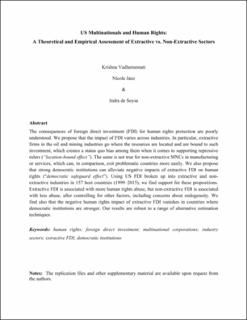| dc.contributor.author | Vadlamannati, Krishna Chaitanya | |
| dc.contributor.author | Janz, Nicole | |
| dc.contributor.author | de Soysa, Indra | |
| dc.date.accessioned | 2021-03-02T15:21:36Z | |
| dc.date.available | 2021-03-02T15:21:36Z | |
| dc.date.created | 2020-07-30T10:13:12Z | |
| dc.date.issued | 2020 | |
| dc.identifier.citation | Business & Society. 2020, 1-39. | en_US |
| dc.identifier.issn | 0007-6503 | |
| dc.identifier.uri | https://hdl.handle.net/11250/2731239 | |
| dc.description.abstract | The consequences of foreign direct investment (FDI) for human rights protection are poorly understood. We propose that the impact of FDI varies across industries. In particular, extractive firms in the oil and mining industries go where the resources are located and are bound to such investment, which creates a status quo bias among them when it comes to supporting repressive rulers (“location-bound effect”). The same is not true for nonextractive multinational corporations (MNCs) in manufacturing or services, which can, in comparison, exit problematic countries more easily. We also propose that strong democratic institutions can alleviate negative impacts of extractive FDI on human rights (“democratic safeguard effect”). Using U.S. FDI broken up into extractive and nonextractive industries in 157 host countries (1999–2015), we find support for these propositions.1 Extractive FDI is associated with more human rights abuse, but nonextractive FDI is associated with less abuse, after controlling for other factors, including concerns about endogeneity. We find also that the negative human rights impact of extractive FDI vanishes in countries where democratic institutions are stronger. Our results are robust to a range of alternative estimation techniques. | en_US |
| dc.language.iso | eng | en_US |
| dc.publisher | SAGE | en_US |
| dc.rights | Attribution-NonCommercial-NoDerivatives 4.0 Internasjonal | * |
| dc.rights.uri | http://creativecommons.org/licenses/by-nc-nd/4.0/deed.no | * |
| dc.title | U.S. Multinationals and Human Rights: A Theoretical and Empirical Assessment of Extractive Versus Nonextractive Sectors | en_US |
| dc.type | Peer reviewed | en_US |
| dc.type | Journal article | en_US |
| dc.description.version | acceptedVersion | en_US |
| dc.source.pagenumber | 1-39 | en_US |
| dc.source.journal | Business & Society | en_US |
| dc.identifier.doi | https://doi.org/10.1177/0007650320928972 | |
| dc.identifier.cristin | 1821023 | |
| dc.description.localcode | © 2020. This is the authors' accepted and refereed manuscript to the article. This manuscript version is made available under the CC-BY-NC-ND 4.0 license http://creativecommons.org/licenses/by-nc-nd/4.0/ | en_US |
| cristin.ispublished | true | |
| cristin.fulltext | original | |
| cristin.fulltext | postprint | |
| cristin.qualitycode | 1 | |

